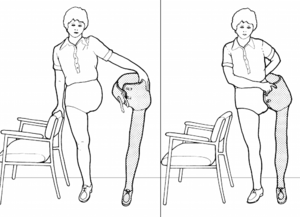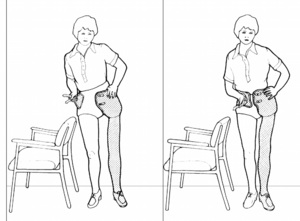Original Editor – Tarina van der Stockt
Top Contributors – Tarina van der Stockt
This is a very extensive amputation usually performed due to malignant bone tumors. Less frequently it is performed due to severe vascular disease, osteomyelitis or trauma. Due to the type of amputation there is no residual limb left and thus no lever to control the prosthesis during gait.
Contents
Socket [1]
A total embracing socket is made by making a plaster cast of the individual’s pelvis allowing the socket to enclose the iliac crest(s). The socket can be made from different types of materials. The socket for a hindquarter amputation will also contain the abdominal and pelvic contents. There are 2 main ways of casting for the socket, using forming blocks or total contact casting
Weight bearing within the socket is transferred to the ischial tuberosity and buttocks of the sound limb for hindquarter amputation, and the ischium and buttock of the amputated side for a hip disarticulation amputation.
Suspension [1]
Total tissue contact is the method used for suspension with the upper edges of the socket grasping/locking over the iliac crests. A shoulder strap can add additional suspension.
Prosthetic Components
Feet
Different feet can be used and should be chosen based upon their weight and stability it will add to the knee joint. Dynamic response feet are commonly used. Read more about Prosthetic Feet using this link.
Knees
Read more about Prosthetic Knees using this link, these are the pros and cons for different prosthetic knees with a hip disarticulation amputation.
- Single-axis knees: For individuals with single slow speed of walking this type of knee is a favourable choice because of its lightweight and friction control.
- Stance control knees: Not used
- Polycentric knees: Used for active individuals who are able to tolerate the increased weight. With a person with a hip disarticulation with no prosthetic hip this knee will allow some knee flexion that will shorten the leg to help with swing.
- Hydraulic knees are not often used because of the increased weight but it may be chosen to initiate hip flexion during the swing phase of gait.
Hip Components/Joints[4][1]
Hip Limiter
This is a mechanism attached on the front of the socket that allows movement of the hip in swing phase. The limiter controls movement that can be adjusted to increase or decrease step length as the individual becomes more active. A locking mechanism can be attached if required by the individual.
Endoskeletal designs: Double anterior and posterior free motion hinges that allow for hip extension by means of rubber bands, and a manual hip lock. It is relatively lightweight. Sitting is difficult due to the distal components.
Energy Storing Interjoint segment
The individual can release energy from the hip joint by changing the amount of pelvic thrust during toe off. This will also help to control the knee extension. Foot rise is controlled and will lead to prosthesis shortening for toe clearance during swing. With this system the prosthesis does not have to be shortened to provide for toe clearance and will prevent gait deviations like vaulting to occur.
Four-bar joint/polycentric
This hip joint allows for an easier and smoother walking pattern because by shortening the length of the prosthesis it helps to clear the foot during swing phase. It is attached on the front of the socket and is therefore not in the way when sitting.
Helix 3D Prosthetic Hip is an example of a more recent polycentric hip joint. This hip leads to a more natural gait by allowing for toe clearance and smooth steps. It is paired with specific microprocessor knees.
References
- ↑ 1.01.11.2 Engstrom B, Van de Ven C, editors. Therapy for amputees. Elsevier Health Sciences; 1999
- ↑ Cale Konetchy. Ottobock Hip Casting Video. Available from: ↑ Martin Bionics. Bikini of Hip Sockets Hammock Casting Stand Explained. Available from: ↑ Stark G. Overview of hip disarticulation prostheses. JPO: Journal of Prosthetics and Orthotics. 2001 Jun 1;13(2):50-3.
- ↑ Chandler Balkman. Helix Hip. Available from: ↑ crystald563. Crystal’s prosthesis for hip disarticulation. Available from:



